by components overheating due to poor airflow in the case because of a buildup of dirt and dust over time. It's worthwhile cleaning your computer annually or even more often if it is in a particularly dusty environment, on carpet or in a household with pets. This tutorial is designed to help you safely clean the interior of your tower or desktop PC so as to maximize its lifespan. No computer knowledge is assumed other than familiarity with component names. Cleaning the computer is not rocket-science and does not require any special skills or tools but you do need to know how to avoid possible damage to some of the more sensitive parts. That's what we will demonstrate here. Although the same principle applies to laptops and notebook PCs, because of the difficulty dismantling them these instructions do not apply to those types of computer.
 back to contents
back to contents
 back to contents
back to contents- A No.2 Philips cross-head screwdriver.
- A small flat-bladed screwdriver.
- One can of compressed air (more if you suspect the PC is really filthy)- from you local supermarket or electronics/computer store.
Do NOT use compressor air - it often has a high moisture content which will cause corrosion
and may contain aerosol lubricants which can cause electrical shorts. - Five or six kitchen paper-towels or napkins to wipe down the case.
- One small paintbrush with long natural bristles. 1/2inch(12mm) size is ideal.
- One packet of Q-Tips or Cotton Tips.
- One Window/Glass Cleaner spray pack.
- A short length of insulating tape.
- One plain Pencil at least 4"(100mm) long.
- A pair of Scissors.
- A flashlight.
- An old Newspaper.
- A Vacuum cleaner with a hose and nozzle (if available).

Optional Items:
- A dust mask - from your local hardware store.
- A Static Strap - from your computer store or possibly supermarket.
- One 3volt Battery type CR2032 or equivalent.
- Assorted coloured stickers.
- A CDROM Lens cleaning disk - available at computer stores or supermarkets.
- Micro cleaning kit - Vacuum cleaner nozzle attachments.
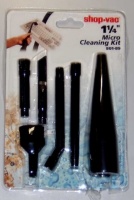
Electrical Precautions
Inside the computer is completely safe with one exception - the power supply or PSU. The PSU is in its own metal box usually at the top rear of a tower (at the rear of a desktop) and you should NEVER attempt to open this box or stick anything metallic into it. There may be an on/off switch at the back of the PSU and there may be a (red) voltage selection switch. Do NOT change the voltage selection switch. Older computers have power at the on/off switch at the front of the case, identified by a thick electrical cable linking the switch to the PSU. Do not attempt to disconnect this cable from the switch. back to contents
back to contents
Inside the computer is completely safe with one exception - the power supply or PSU. The PSU is in its own metal box usually at the top rear of a tower (at the rear of a desktop) and you should NEVER attempt to open this box or stick anything metallic into it. There may be an on/off switch at the back of the PSU and there may be a (red) voltage selection switch. Do NOT change the voltage selection switch. Older computers have power at the on/off switch at the front of the case, identified by a thick electrical cable linking the switch to the PSU. Do not attempt to disconnect this cable from the switch.
 back to contents
back to contents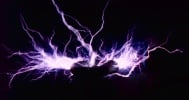
The greatest danger inside the tower is of you "electrocuting" the computer through discharge of static electricity that builds up on your body or clothing. Static is especially a problem during dry weather and if you have synthetic carpets or clothing. For example a synthetic pullover (sweater) would be a bad choice of garment for this job, a short sleeved cotton shirt would be a much better choice. The best way to combat static while cleaning your computer is to wear a static strap attached to the chassis and worn on your wrist during the whole process. Disposable static straps are available for a few dollars, professional versions may cost $30-40. Alternatively if you can maintain good contact between yourself and the metal chassis for most of the cleaning process and try not to move around too much then that will be adequate without a strap.
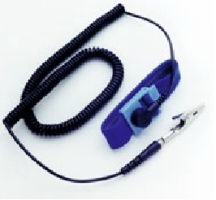
Dust Precautions
Computers make pretty good dust collectors and if yours is normally placed on or near the floor (especially carpeted floor) or if you have pets, are a smoker, or the computer is situated in a high pollution area there could be a lot of dirt trapped in the system. When you blow this out with the compressed air it will be spread through the room. You should work with good ventilation and if you suffer from allergies you should consider wearing a dust mask. back to contents
back to contents
Computers make pretty good dust collectors and if yours is normally placed on or near the floor (especially carpeted floor) or if you have pets, are a smoker, or the computer is situated in a high pollution area there could be a lot of dirt trapped in the system. When you blow this out with the compressed air it will be spread through the room. You should work with good ventilation and if you suffer from allergies you should consider wearing a dust mask.
 back to contents
back to contents
Setting Up
Shutdown the computer and disconnect all the cables plugged into it (you may want to mark the cables and the ports they came from with coloured stickers to help you when putting your computer back together again). You may need the flat-bladed screwdriver to undo some of the connector screws. Put newspaper down on your work surface so it doesn't get scratched. Locate your worksurface near a power outlet (power point) and plug in the computer power cord (you don't need to switch it on). Put the computer on your work surface and connect the power cord to the computer but do not turn it on. Set out your tools and materials so you do not need to move around much to reach them during cleaning. Starting about two inches (50mm) from the blunt end of the pencil fasten insulating tape down the length of the pencil to the blunt end and cut the tape 2"(50mm) beyond the end of the pencil. Smooth the tape around the pencil then fold the excess length over the blunt end and up the other side. Press the tape down so it is firmly stuck to the length of the pencil. back to contents
back to contents
Shutdown the computer and disconnect all the cables plugged into it (you may want to mark the cables and the ports they came from with coloured stickers to help you when putting your computer back together again). You may need the flat-bladed screwdriver to undo some of the connector screws. Put newspaper down on your work surface so it doesn't get scratched. Locate your worksurface near a power outlet (power point) and plug in the computer power cord (you don't need to switch it on). Put the computer on your work surface and connect the power cord to the computer but do not turn it on. Set out your tools and materials so you do not need to move around much to reach them during cleaning. Starting about two inches (50mm) from the blunt end of the pencil fasten insulating tape down the length of the pencil to the blunt end and cut the tape 2"(50mm) beyond the end of the pencil. Smooth the tape around the pencil then fold the excess length over the blunt end and up the other side. Press the tape down so it is firmly stuck to the length of the pencil.
 back to contents
back to contents
Opening the Case
The standard tower case usually has either a single metal cover covering the top and both sides, held in place by three or four screws or has removable side panels each held in place by two screws.
The standard tower case usually has either a single metal cover covering the top and both sides, held in place by three or four screws or has removable side panels each held in place by two screws.
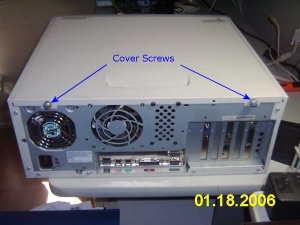
Use the Philips screwdriver to remove the three or four screws holding on the cover(s) and put them aside where they will not be lost. Remove the cover(s) and put them to one side but within reach. If you are using a static strap put it on your wrist and attach it to a metal part of the chasis, if you do not have a static strap touch the metal of the chasis with both hands. Then remove the power cord from the back of the computer.  back to contents
back to contents
 back to contents
back to contents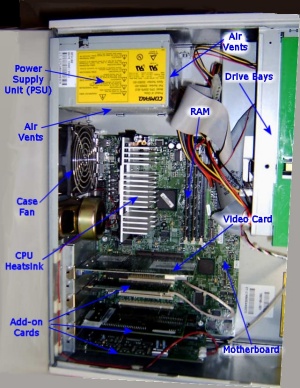

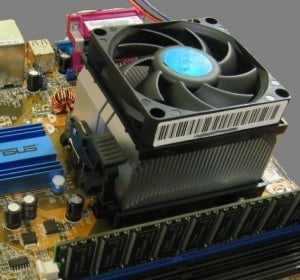

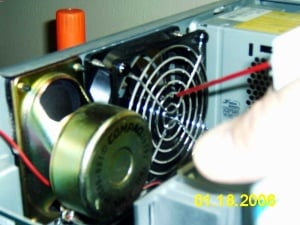
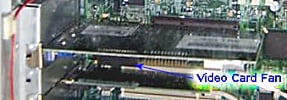


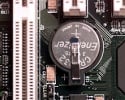
- Case vents and PSU vents Run the vacuum cleaner nozzle over any air vents at the front, side and rear of the case and over any vents in the PSU especially the air vents in the sides of the PSU inside the computer. If the covers have vents then vacuum those as well.
- PSU fans Use the blunt, insulated end of the pencil to hold the fan blades steady and blow compressed air into the PSU fan(s) and through the PSU. Significant dust may be ejected from the power supply .
- CPU fan and heatsink This is the most important part of the cooling system - dirt collects on the fan blades and clogs the heatsink vanes. Use the paintbrush to brush the dirt off each blade and off the heatsink vanes if accessible. Using the pencil to hold the fan blades still, blow out the fan and the heatsink with the compressed air. It is important not to let the CPU fan (or other fans) spin up under the air blast as damaging voltages can be generated through a dynamo effect. Expect significant dirt to be ejected from the CPU heatsink. If you want to be particularly thorough moisten a Cotton-tip with glass cleaning fluid and wipe down the upper and lower surface of each fan blade.
- RAM Sticks and Expansion Slots Dirt can sometimes build up in 'drifts' around the memory sticks and the video, sound or modem card slots. Use the compressed air to blow it out. Do not use the brush here.
- Case fans Cases often have one or more fans attached to the front or rear panels. Using the pencil to stop fan rotation blow the dirt from the case fans with the brush and compressed air.
- Video card fan and heatsink This can be hard to see as it is usually on the lower side of the video card. Depending on the design either use the paintbrush to remove dirt from the heatsink and/or use compressed air while holding the fan still with the pencil. To do a thorough job will probably require removing the Video Card which is normally held in place with one screw where it meets the case. Remove the screw and unplug the card by pulling firmly outwards. There may be a plastic latch at the back of the card, press down on this to help eject it. If you do remove the video card keep good contact with the PC chassis as often as possible to minimise static buildup and rest the video card on part of the case while it is being cleaned. When the fan is clean use compressed air to blow out the video card slot, on older cards if the edge connectors of the card look tarnished clean them lightly with a pencil erasor. Reinsert the video card making sure the plastic latch clips into place indicating the card is properly seated in the slot (not all systems have a latch). Then do up the screw.
- The case Vacuum the dust from the bottom of the case being careful to keep the nozzle away from the motherboard. Spray some paper towels with glass cleaner and wipe down the flat metal surfaces of the case and the inside of the cover(s).
- The Ports Dust often accumulates in the I/O Ports where you plug in peripherals on the back of the computer. Use the brush and compressed air to clean them out.
- CMOS battery Although this is not a cleaning process, if your PC is more than a couple of years old this might be a good time to change the CMOS battery - usually a round, silver-coloured button battery e.g. Energiser CR2032 Lithium 3v. The battery 'pops' out of its holder with a little pressure on the side near the clip and the replacement slips in. Note: Changing the battery may reset some BIOS options to factory defaults so If you have complex BIOS settings because of SATA drives, USB keyboards, RAID controllers or network parameters for example it would be best to note down all the settings before changing the battery and check for changes afterward.

Floppy drives can collect a lot of dust which could prevent them from working properly. Push the nozzle of the compressed-air can a little way into the drive opening so that the flap is held open, or use Cotton-tips to hold the flap open wide, then use the compressed air to blow out the dust. There are special floppy cleaning disks available which are used to clean the floppy drive read/write heads but these are often more expensive than replacing the drive and are only needed if the drive is old or gets very heavy usage.
The CDROM drives or DVD drives are unlikely to be clogged by dust but they may collect dirt on the optical lens which can cause errors. Use the CD lens cleaning disk following the manufacturer's instructions to clean the lenses on these drives - this has to be done when the PC is operating.
Hard Drives are sealed units and require no cleaning, but to maximise the air-flow around them use the compressed air to blow away any dust from the drive's upper surfaces. back to contents
back to contents
The CDROM drives or DVD drives are unlikely to be clogged by dust but they may collect dirt on the optical lens which can cause errors. Use the CD lens cleaning disk following the manufacturer's instructions to clean the lenses on these drives - this has to be done when the PC is operating.
Hard Drives are sealed units and require no cleaning, but to maximise the air-flow around them use the compressed air to blow away any dust from the drive's upper surfaces.
 back to contents
back to contents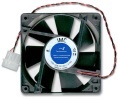
Connect your PC power cable again and switch on the PC, while it is open, for just long enough to see that all the fans you identified above are spinning. Fans which do not spin turn into miniature heaters which makes the situation worse than without a fan. If you find a fan which is not working then, after turning off the PC, note what kind of fan it is, where it is and, if possible, unplug it. You can probably order a replacement online or they may have stock in your local computer store. If the CPU fan is not working then you should not run the computer for more than a few minutes until it is replaced. If the PC has started to boot while you were inspecting the fans and is reluctant to turn off, just hold the power button in for about 5 seconds and the PC will switch off.

0 comments: